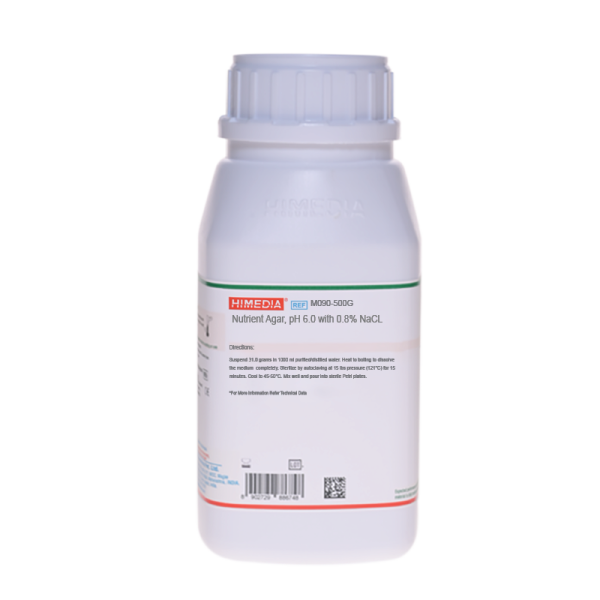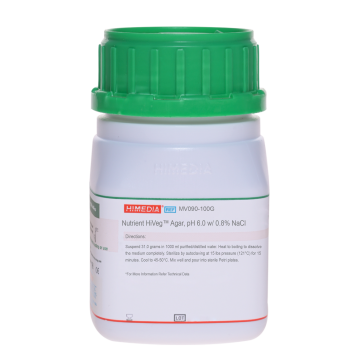 Your enquiry has been submitted
Your enquiry has been submitted
Nutrient Agar, pH 6.0 w/ 0.8% NaCl
Intended Use
Recommended for cultivation of bacteria requiring slightly acidic pH.
Composition
| Ingredients | Gms / Litre |
|---|---|
| Peptone | 5.000 |
| HM peptone B # | 3.000 |
| Sodium chloride | 8.000 |
| Agar | 15.000 |
Final pH (at 25°C): 6.0±0.2
**Formula adjusted, standardized to suit performance parameters
# Equivalent to Beef extract
Directions
Suspend 31 grams in 1000 ml purified / distilled water. Heat to boiling to dissolve the medium completely. Sterilize by autoclaving at 15 lbs pressure (121°C) for 15 minutes. Cool to 45-50°C. Mix well and pour into sterile Petri plates.
Principle And Interpretation
Nutrient Media are general purpose media used for the examination of water and dairy products according to Standard Methods for the Examination of Water and Waste water (2) and Dairy Products (1). Nutrient Agar, pH 6.0 with 0.8% NaCl is a modification of Nutrient Agar w/ 0.8% NaCl and recommended by APHA (5). In the former, the pH of the medium is adjusted to 6.0 to allow the growth of organisms requiring slightly acidic pH. Since the medium contains 0.8% sodium chloride, it can be used as a base for enrichment with blood or ascetic fluid or other supplements for cultivation of fastidious microorganisms.
Sodium chloride maintains the osmotic balance so that red blood cells do not rupture when blood is added as supplement (2). HM peptone B and Peptone provide the necessary nitrogen compounds, carbon, vitamins and also some trace ingredients to the nonfastidious organisms like Bacillus subtilis and Staphylococcus aureus. Sodium chloride maintains osmotic equilibrium of the medium.
Type of specimen
Dairy samples; Water samples
Specimen Collection and Handling
For dairy samples, follow appropriate techniques for sample collection and processing as per guidelines (1,6).
For water samples, follow appropriate techniques for sample collection, processing as per guidelines and local standards.(2)
After use, contaminated materials must be sterilized by autoclaving before discarding.
Warning and Precautions
Read the label before opening the container. Wear protective gloves/protective clothing/eye protection/ face protection. Follow good microbiological lab practices while handling specimens and culture. Standard precautions as per established guidelines should be followed while handling specimens. Safety guidelines may be referred in individual safety data sheets.
Limitations
- Further biochemical and serological tests must be carried out for further identification.
Performance and Evaluation
Performance of the medium is expected when used as per the direction on the label within the expiry period when stored at recommended temperature.
Quality Control
Appearance Cream to yellow homogeneous free flowing powder
Gelling Firm, comparable with 1.5% Agar gel
Colour and Clarity of prepared medium Light yellow to amber coloured clear to slightly opalescent gel forms in Petri plates
Reaction Reaction of 3.1% w/v aqueous solution at 25°C. pH: 6.0±0.2
pH 5.80-6.20
Cultural Response Cultural characteristics observed after an incubation at 35-37°C for 18-48 hours.
| Organism | Inoculum (CFU) | Growth | Recovery |
|---|---|---|---|
| Bacillus subtilis subsp. spizizenii ATCC 6633 (00003*) | 50-100 | good | 50-70% |
| Candida albicans ATCC 10231 (00054*) | 50-100 | luxuriant | >=70% |
| Staphylococcus aureus subsp. aureus ATCC 25923 (00034*) | 50-100 | good | 50-70% |
Key: *Corresponding WDCM numbers.
Storage and Shelf Life
Store between 10-30°C in a tightly closed container and the prepared medium at 20-30°C. Use before expiry date on the label. On opening, product should be properly stored dry, after tightly capping the bottle in order to prevent lump formation due to the hygroscopic nature of the product. Improper storage of the product may lead to lump formation. Store in dry ventilated area protected from extremes of temperature and sources of ignition. Seal the container tightly after use. Product performance is best if used within stated expiry period.
Disposal
User must ensure safe disposal by autoclaving and/or incineration of used or unusable preparations of this product. Follow established laboratory procedures in disposing of infectious materials and material that comes into contact with sample must be decontaminated and disposed of in accordance with current laboratory techniques (3,4).
Reference
- American Public Health Association, 1978, Standard Methods for the Examination of Dairy Products, 14th Ed., APHA, Inc., Washington, D.C.
- Clesceri L. S, Greenberg A. E. and Eaton A. D., (Eds.), 1998, Standard Methods for the Examination of Water and Wastewater, 20th Ed., APHA, Washington, D.C.
- Isenberg, H.D. Clinical Microbiology Procedures Handbook 2nd Edition.
- Jorgensen, J.H., Pfaller, M.A., Carroll, K.C., Funke, G., Landry, M.L., Richter, S.S and Warnock., D.W. (2015) Manual of Clinical Microbiology, 11th Edition. Vol. 1.
- Salfinger Y., and Tortorello M.L., 2015, Compendium of Methods for the Microbiological Examination of Foods, 5th Ed., American Public Health Association, Washington, D.C.
- Wehr H. M. and Frank J. H., 2004, Standard Methods for the Microbiological Examination of Dairy Products, 17th Ed., APHA Inc., Washington, D.C.
| Product Name | Nutrient Agar, pH 6.0 w/ 0.8% NaCl |
|---|---|
| SKU | M090 |
| Product Type | Regular |
| Physical Form | Powder |
| Origin | Animal |
| Packaging type | HDPE |
| References | 1. Clesceri L. S, Greenberg A. E. and Eaton A. D., (Eds.), 1998, Standard Methods for the Examination of Water andWastewater, 20th Ed., APHA, Washington, D.C. 2.American Public Health Association, 1978, Standard Methods for the Examination of Dairy Products, 14th Ed., APHA,Inc., Washington, D.C. 3.Downes F. P. and Ito K., (Eds.), 2001, Compendium of Methods for the Microbiological Examination of Foods, 4th Ed.,American Public Health Association, Washington, D.C. |
| Customized Product Available | No |





